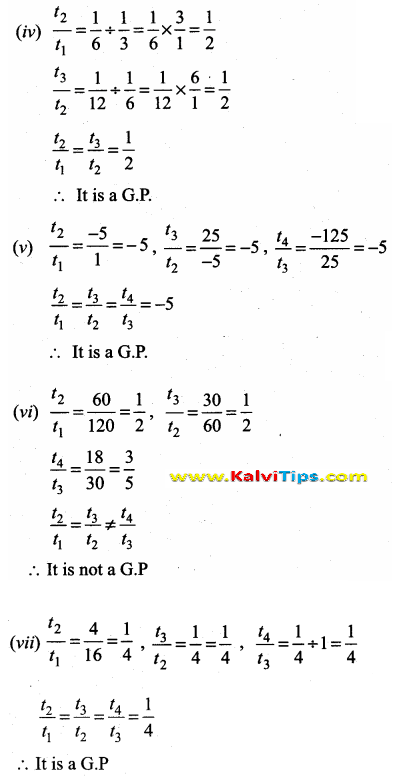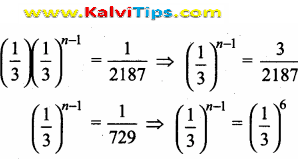Tamil Nadu Board 10th Standard Maths - Chapter 2 Excercise 2.7: Book Back Answers and Solutions
This post covers the book back answers and solutions for Chapter 2 Excercise 2.7 – Maths from the Tamil Nadu State Board 10th Standard Maths textbook. These detailed answers have been carefully prepared by our expert teachers at KalviTips.com.
We have explained each answer in a simple, easy-to-understand format, highlighting important points step by step under the relevant subtopics. Students are advised to read and memorize these subtopics thoroughly. Once you understand the main concepts, you’ll be able to connect other related points with real-life examples and confidently present them in your tests and exams.
By going through this material, you’ll gain a strong understanding of Chapter 2 Excercise 2.7 along with the corresponding book back questions and answers (PDF format).
Question Types Covered:
- 1 Mark Questions: Choose the correct answer, Fill in the blanks, Identify the correct statement, Match the following
- 2 Mark Questions: Answer briefly
- 3, 4, and 5 Mark Questions: Answer in detail
All answers are presented in a clear and student-friendly manner, focusing on key points to help you score full marks.
All the best, Class 10 students! Prepare well and aim for top scores. Thank you!
Chapter 2 Numbers and Sequences Ex 2.7
(i) 3,9,27,81,…
(ii) 4,44,444,4444,…
(iii) 0.5,0.05,0.005,
(iv) , ………….
(v) 1, -5, 25,-125,…
(vi) 120, 60, 30, 18,…
(vii) 16, 4, 1, , ……….
Answer Key:

%20-%20English%20medium%20Guides.png)
(i) a = 6, r = 3
Answer Key:
a = 6, r = 3
ar = 6 × 3 = 18,
ar2 = 6 × 9 = 54
The three terms are 6, 18 and 54
Answer Key:
ar = ×= 2,
ar2 = × 2 = 2
The three terms are , 2 and 2
Answer Key:
ar = 1000 × = 400,
ar2 = 1000 × = 40 × 4 = 160
The three terms are 1000,400 and 160.
Answer Key:
The G.P. is 729, 243, 81,….

Answer Key:
G.P = x + 6, x + 12, x + 15
In G.P r =
(x + 12)2 = (x + 6) (x + 5)
x2 + 24x + 144 = x2 + 6x + 15x + 90
24x – 21x = 90 – 144
3x = -54
x = = -18
x = -18
Answer Key:
Here a = 4; r = = 2
tn = 8192

2n-1 = = 2048
2n-1 = 211 ⇒ n – 1 = 11
n = 11 + 1 ⇒ n = 12
Number of terms = 12
Answer Key:
%20-%20English%20medium%20Guides.png)
a. rn-1 =
%20-%20English%20medium%20Guides.png)
Number of terms = 7
Answer Key:
Given, 9th term = 32805
a. rn-1 =
t9 = 32805 [tn = arn-1]
a.r8 = 32805 …..(1)
6th term = 1215
a.r5 = 1215 …..(2)
Divide (1) by (2)
r3 = 27 ⇒ r3 = 33
r = 3
Substitute the value of r = 3 in (2)
a. 35 = 1215
a × 243 = 1215
a =
Here a = 5, r = 3, n = 12
t12 = 5 × 3(12-1)
= 5 × 311
∴ 12th term of a G.P. = 5 × 311
Answer Key:
t8 = 768 = ar7
r = 2
t10 = ar9 = ar7 × r × r
= 768 × 2 × 2 = 3072
Answer Key:
a, b, c are in A.P.
t2 – t1 = t3 – t2
b – a = c – b
2b = a + c …..(1)
3a, 3b, 3c are in G.P.
3a, 3b, 3c are in G.P.

Answer Key:
Let the three terms of the G.P. be
Product of three terms = 27
a3 = 27 ⇒ a3 = 33
a = 3
Sum of the product of two terms taken at a time is

6r2 – 9r – 4r + 6 = 0
3r (2r – 3) -2(2r – 3) = 0
(2r – 3) (3r – 2) = 0
2r – 3 = 0 or 3r – 2 = 0
2r = 3 (or) 3r – 2 = 0
r =
%20-%20English%20medium%20Guides.png)
Answer Key:
Starting salary (a) = ₹ 60000
Increased salary = 5% of starting salary
=
= ₹ 3000
Starting salary for the 2nd year = 60000 + 3000
= ₹ 63000
Year increase = 5% of 63000
=
= ₹ 3150
Starting salary for the 3rd year = 63000 + 3150
= ₹ 66150
60000, 63000, 66150,…. form a G.P.
a = 60000; r =
tn = ann-1
t5 = (60000) (
= 60000 ×
=
= 72930.38
5% increase =
= ₹ 3646.51
Salary after 5 years = ₹ 72930.38 + 3646.51
= ₹ 76576.90
Offer B: ₹22,000 to start with followed by a guaranteed annual increase of 3% for the first 5 years.
What is his salary in the 4th year with respect to the offers A and B?
Answer Key:
Starting salary (a) = ₹ 20,000
Annual increase = 6% of 20000
=
= ₹ 1200
Salary for the 2nd year = ₹ 20000 + 1200
= ₹ 21200
Here a = 20,000; r =
n = 4 years
tn = arn-1

Starting salary = ₹ 22000
(a) = 22000
Annual increase = 3% of 22000
=
= ₹ 660
Salary for the 2nd year = ₹ 22000 + ₹ 660
= ₹ 22,660
Here a = 22000; r =
=
Salary at the end of 4th year = 22000 × (
= 22000 × (
= 22000 ×
4th year Salary for A = ₹ 23820 and 4th year Salary for B = ₹ 24040
Answer Key:
a, b, c are three consecutive terms of an A.P
∴ a = a, b = a + dand c = a + 2d respectively ….(1)
x, y, z are three consecutive terms of a G.P
∴ x = x, y = xr, z = xr2 respective ……(2)
L.H.S = xb-c × yc-a × za-b ( Substitute the values from 1 and 2 we get)

Hence it is proved









0 Comments:
Post a Comment